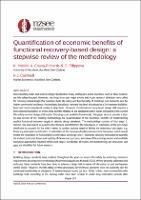Quantification of economic benefits of functional recovery-based design: a stepwise review of the methodology

Download
Date
2024-04-09Authors
Habibi, Kasra
Cardwell, Robert
Chang-Richards, Alice
Filippova, Olga
Metadata
Show full item recordAbstract
Recent earthquake experiences have shown that although life-safety objectives have been met, current seismic design standards were unable to ensure an acceptable level of robustness and recovery timeframe for all modern buildings. To remedy, recent research direction has proposed that design standards aim for higher community resilience in their requirements by introducing the concept of functional recovery as a link between building-level and community-level resilience objectives. Functional recovery ensures restoration of basic intended functions within a target timeframe post-hazard. However, functional recovery-based design still requires a firm rational foundation in terms of its benefits relative to the additional cost it incurs compared to the current life-safety-centred design philosophy. This paper provides a step-by-step review of the methodology for quantification of the economic benefits of implementing explicit functional recovery targets in seismic design standards. The methodology consists of four steps: 1. seismic risk assessment to quantify direct losses and determine the robustness, 2. estimation of the pre-repair timeframe to account for the time it takes to conduct actions required before the restoration can begin, e.g., financing and mobilization, 3. estimation of the duration of utility infrastructure disruption, which would inhibit the restoration of function to individual buildings, and 4. economic recovery simulation to quantify the indirect economic losses and rapidity of the recovery process. In this paper, a critical review of the available models and analytical approaches required within each step is conducted, the strengths and shortcomings of each approach are pronounced, and gaps are identified for future research.
